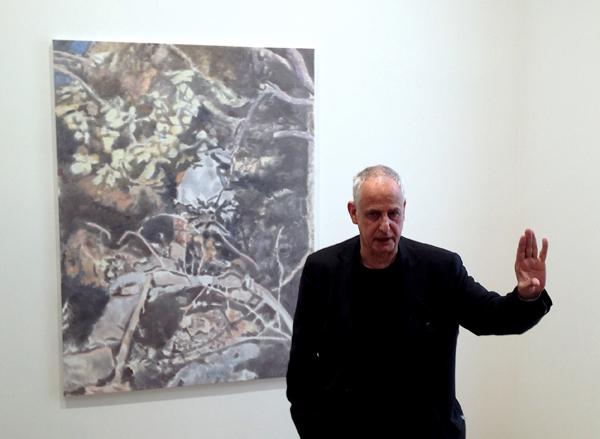David Zwirner presents an exhibition of new paintings by Luc Tuymans, on view at the London gallery, which Tuymans inaugurated in October 2012 with the exhibition ‘Allo!’. This new exhibition ‘The Shore’ includes work that the artist specifically made for this space. The artist is known for his light washed out canvases, handled with Tuymans’s characteristic short stabbing brushstrokes and vigorous mark making, the artist’s subjects are varied from the Holocaust, to the banality of wallpaper patterns. Tuymans is one of Europe’s most influential painters – and this current exhibition features some rather dark subject matters – a portrait of Japanese killer Issei Sagawa and ‘The Shore’, a ‘really dark’ painting of a German submarine crew about to be shot.
What contemporises Tuymans’ work is the artist’s process. Tuymans often sources his images from around him; the act of appropriation is central to the artist’s practice, as with fellow artists, Richard Prince, and Jeff Koons among others – Tuymans often uses his iPhone to appropriate an existing image, re-contextualising it in a painting. Other appropriations have included drawings, photographs, and film stills. The artist started to use Polaroids in 1995. Much like Prince, the re-cropping of the image serves to change its meaning. The resulting works often appear slightly out-of-focus, but the blurriness is actually sharp because, unlike Gerhard Richter, it is largely not wiped away, but the blur is created by Tuymans’ paddled brushstrokes.
Prince would argue that his invention of the ‘Re-photograph’ served to remind the viewer of the viral nature of banality. The ultimate statement of Prince’s Re-photography is that the primary image exists. The work becomes a simulation of the artist being seduced by an original image, re-contextualised; much the same could be said of Tuymans’ practice except the next step is far greater in committing the image to another medium entirely, and sometimes the images are re-photographed several times. But these works do re-enact a kind of seduction. Tuymans paintings do flirt with banality, with the artist’s interest in the domestic, and wallpaper, but then Tuymans suddenly throws the viewer headlong into philosophy, politics, and violence.
The use of technology in the artist’s practice lends a particularly contemporaneous bent to the finished paintings – but the link is not always apparent when viewing the works. The juxtaposition between paintings that don’t necessarily convey a principle that has its roots firmly embedded in the image saturated digital world, and the use of an iPhone to make paintings that places Tuymans firmly in the present.
The intensity of the artist’s close-up portraits zoomed as if cropped from a screen, is balanced by two near-monochrome paintings depicting an obelisk in a wooded landscape and a single, puffy cloud respectively. The cloud is based on the wallpaper of a luxury hotel that Tuymans visited on a Edinburgh trip.
The artist steps from the domestic and banal to the horrors of war. Tuymans has noted that he strived to make a “really dark” painting for a long time, and The Shore – is something uncharacteristic for the artist, in that it is dark in hue as well as content – and breaks with Tuymans usually lighter works – in colour if not subject matter. But as the artist stated although dark – Tuymans never uses black. It can be believed when the artist states a profound, if gradual, influence of Francisco Goya on his work. Tuymans victims in ‘The Shore’ are unspecified and undifferentiated, the dramas evoked in Goya’s Black Paintings are referenced in the work: the slaughter as meaningless as it is universal.
In the work ‘Issei Sagawa’, is a portrait of the notorious Japanese cannibal known for killing and eating a fellow student at the Sorbonne University in Paris in the early 1980s, but is now a free man today following the end of his prison sentence. It is the third time that Tuymans paints his portrait – with uncharacteristically loose and gestural brushwork by the artist. The work sits uncomfortably with the viewer; as a disturbing image akin to that of horror movie fiction; but the work is taken from a real image of the killer wearing a mask.
Tuymans’ practice of appropriation, and the zooming in on the primary image serves to render a blurriness both painterly, and philosophical. But the artist is very much about the paint, recently citing how the iPhone turned his whites blue in reproduction; something the artist mirrored in the painting process. Tuymans’ canvases may not necessarily convey the direct link that the artist’s practice has with technology and this media saturated age.
But Tuymans’ use of paint results in bleached impenetrable surfaces that appear to emanate light, alluding to a zoomed image on a digital monitor, or the freshly snapped image on an iPhone screen. Tuymans’ works are like paintings of digital reproductions that have been trapped in a loop until the image has degraded, expressing both the intimate and the viral nature of the image in the contemporary world.
Luc Tuymans: The Shore – David Zwirner Gallery – until 2 April 2015
Words: Paul Black Photo: P C Robinson © Artlyst 2015 all rights reserved

